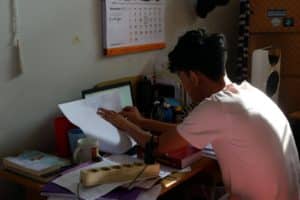What is a 2nd pillar buyback?
A buyout in the 2nd pillar takes place when an insured person makes payments into his or her pension plan. This makes it possible to increase services in filling any "gaps" in contributions, e.g. due to a career break, a disability, a late arrival in the Swiss system, or an under-contribution in the past. These additional payments increase directly your assets of your pension plan.
Tax benefits
Just like payments into your 3rd pillar, 2nd pillar purchases are deductible of your taxable income. In other words, the amount you buy back is deducted from your gross annual income, thereby reducing your taxable basis and therefore your annual tax bill.
Unlike the 3rd pillar, which has an annual deduction ceiling, 2nd pillar purchases can, depending on the gap, represent much higher amounts, offering significant tax reduction potential. What's more, 2nd pillar assets are exempt from wealth tax. Interest expenses are also not included in your taxable income.
Reduced taxation on withdrawal
If the policyholder chooses to withdraw his or her 2nd pillar in the form of a lump sum (rather than receive it in the form of an annuity), it will be taxed separately from other income at a reduced rate. This rate is lower than that applicable to ordinary income tax.
That's why some people prefer to opt for a capital withdrawal (partial or total) to take advantage of the lower tax rate, since once retired, annuities are taxed as ordinary income.
2nd pillar purchase amounts
Your pension fund provides you with a pension certificate each year, showing the maximum redemption amount that you are authorized to contribute. This amount is calculated on the basis of data known to the fund, such as your age, your insured salary and your contribution history.
In case of assets
If you have assets invested in a vested benefits account, these must be taken into account, as they reduce your buy-back potential. The pension fund does not always have access to this information, so it's important to check your situation before making a purchase.
In the event of early withdrawal
If you have already made a early withdrawal from your 2nd pillar for the purchase of a home, you will have to reimburse this amount before you are allowed to make further tax-deductible surrenders. This means that until you have repaid the full amount of the early withdrawal, you will not be able to benefit from tax deductions for further repurchases.
In all cases, to ensure that your voluntary purchases are recognized as deductible, it is strongly recommended that you ask your pension fund for a official estimate of your redemption potential.
What are the disadvantages of a buyback?
Although 2nd pillar buy-ins offer tax advantages and can improve retirement benefits, they also present some The disadvantages that it's important to understand before making a decision.
Limited access to funds
Once you have made a purchase in the 2nd pillar, this money is normally blocked until retirement. It is not possible to withdraw these funds before then, except in certain situations such as the purchase of a principal residence, definitive departure from Switzerland or the launch of an activity of self-employment.
Other disadvantages
2nd pillar funds are often invested in a conservatory kind of way.The amount of your future pension depends on the financial strength of your pension fund. It's worth noting that the effects of one or more 2nd pillar purchases are felt most strongly in the long term.
2nd pillar purchase VS Pillar 3a payments
Payments into the pillar 3a are also deductible from your taxable income, but with an annual ceiling. In 2024, this ceiling is CHF 7,056 for employees affiliated to the 2nd pillar and CHF 35,280 for the self-employed. Pillar 3a returns are tax-free for the duration of the investment, and the capital withdrawn is taxed at a reduced rate, similar to the 2nd pillar, but often with greater flexibility.
If you have paid the maximum amount in your Pillar 3a, it may make sense to make Pillar 2 purchases, as these are also tax-deductible, and the amount purchased immediately reduces income tax.
Purchase of 2nd pillar with a 3rd pillar
If you have a pension deficit in your pension fund, you can make up for it by transferring assets from the 3rd pillar up to normal retirement age, and even up to five years afterwards if you are still working. This transfer enables you to improve your retirement benefits, since pensions from a pension fund are generally more advantageous than life annuities from Pillar 3a.
The transfer from the 3rd pillar to the 2nd pillar is tax-neutral. This means that your assets Your pension contributions do not increase overall, so you cannot benefit from a tax deduction. It is generally advisable to use free assets to buy into the 2nd pillar, as this allows you to increase your retirement assets while benefiting from a tax deduction.
Frequently Asked Questions
What is the maximum purchase limit for the 2nd pillar?
The maximum amount you can buy back under the 2nd pillar depends on your insured salary, your age, your missing contribution years, and any early withdrawals (e.g. to buy a home). Your pension fund will provide you with a pension certificate indicating this amount.
Can I buy into the 2nd pillar as a cross-border commuter?
Yes, as a cross-border commuter, you can buy into the 2nd pillar, provided you are affiliated to a Swiss pension fund. This means that if you work in Switzerland and contribute to the 2nd pillar, you have the option of filling contribution gaps by making a purchase.
What is the age limit for buying into the 2nd pillar?
The age limit for buying into the 2nd pillar in Switzerland is the legal retirement age, i.e. 64 for women and 65 for men. However, purchases can be made up to 5 years after retirement age, if you are still working.
What are the tax deductions for buying into the 2nd pillar?
The amount you purchase in the 2nd pillar is deducted from your taxable income for the year in which the purchase is made. Pillar 2 capital is not taxed during the savings phase, but only on withdrawal, whether as an annuity (taxed as ordinary income) or as capital (taxed separately at a reduced rate).
When can you withdraw your 2nd pillar?
You can withdraw your 2nd pillar in the situations conditions:
- At retirement, when you can choose to receive all the capital instead of converting it into annuities.
- For the purchase of real estate, by withdrawing the funds in the form of capital.
- By becoming self-employed, to bring funds into the business.
- When leaving Switzerland, under certain conditions.





